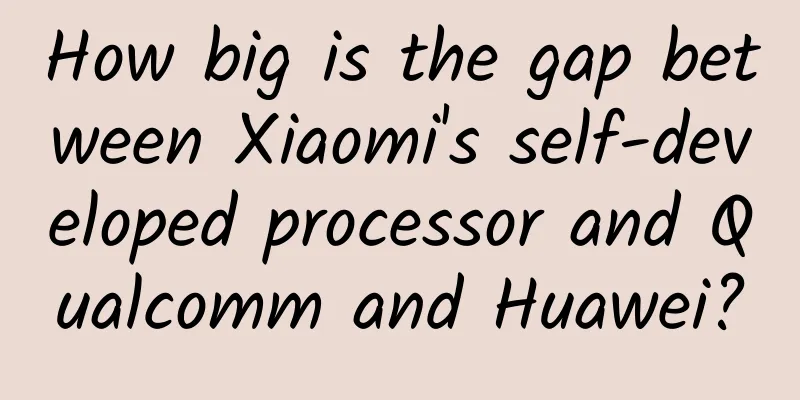How big is the gap between Xiaomi's self-developed processor and Qualcomm and Huawei?

|
Recently, a new Xiaomi phone was exposed online with a wave of real photos. Compared with the attention paid by netizens to the new Xiaomi phone, more netizens focused on the phone chip. According to a photo, the screen of the phone is 5.46 inches (some sources say it is actually 5.15 inches) 1080P display, 8-core CPU, the highest main frequency is 2.2GHz, GPU is Mali-T860 MP4, AnTuTu running score is 63581, and the running score result is about the same level as Qualcomm Snapdragon 625. In addition, there is a photo with the system Android 6.0 and pinecone. So, what is the SoC of this phone suspected to be developed by Xiaomi? Which product of Qualcomm and Huawei is it roughly equivalent to? What will be the future development prospects? What is the true face of the SoC developed by Xiaomi? Just as any technological achievement will not fall from the sky or appear out of thin air, the SoC developed by Xiaomi is also the result of seeking technical support from the outside world and practicing internal skills for 2 years. As early as the end of 2014, Xiaomi and Datang Unicore started technical cooperation. Datang Telecom licensed the LC1860 platform developed and owned by Unicore Technology Co., Ltd., a wholly-owned subsidiary of Datang Telecom, to Beijing Songguo Electronics Co., Ltd. for 103 million yuan. Beijing Songguo Electronics Co., Ltd. was jointly invested by Xiaomi and Unicore, with Xiaomi holding 51% and Unicore holding 49%. The English name is exactly pinecore that appears in the real phone photo. Thanks to the technical cooperation between Beijing Songguo and Unicore Technology, Beijing Songguo is able to participate in the development of 4G multi-mode SOC series chip products and use them on Xiaomi mobile phones. In fact, the mobile phone chip disclosed this time is not the first product developed by Unicore for Xiaomi mobile phones. As early as 2015, LC1860 was used in the Redmi 2A mobile phone, and the shipment volume exceeded 5 million units that year. The market performance was much better than Huawei HiSilicon's early trial products K3 and K3V2, and was close to HiSilicon Kirin 910. The recently exposed SoC designed by Pinecone Electronics is obviously the latest result of the cooperation between Xiaomi and Leadcore Technology. So what is the performance of this chip? First of all, let's look at the CPU. According to the existing information, the CPU part of this SoC is a quad-core 1.4G Cortex A53 and a quad-core 2.2G Cortex A53, which is in the same class as HiSilicon Kirin 650 (quad-core 2.0GHz A53 4-core 1.7GHz A53), Qualcomm Snapdragon 616 (quad-core 1.7GHz A53 4-core 1.2GHz A53), and Qualcomm Snapdragon 625 (octa-core 2.0Ghz A53). Secondly , let's look at the GPU. Pinecone's GPU is Mali T860 MP4, which is obviously better than the Mali T830 MP2 of HiSilicon Kirin 650. Let's look at the manufacturing process, although there is no news about the specific manufacturing process of this SoC at this stage. However, according to the fact that SMIC announced the successful tape-out of its 28nm HKMG process in February this year, and launched a mobile phone SoC based on 28nm HKMG with Leadcore Technology, as well as the fact that Datang Telecom is a major shareholder of SMIC and Leadcore Technology is a wholly-owned subsidiary of Datang Telecom, the Pinecone SoC exposed this time is likely to be tape-outed using SMIC's 28nm HKMG process. Although the 28nm HKMG process is different from Huawei's Kirin 650's 16nm manufacturing process and Qualcomm's Snapdragon 625's 14nm process, it is already better than Qualcomm's Snapdragon 615's 28nm LP process. As for why the 14nm/16nm process is not adopted, on the one hand, it is because the 28nm HKMG process is relatively mature, and the mask cost is only about 6 million US dollars, which is significantly lower than the 14nm/16nm process; on the other hand, it is also because it is difficult for Xiaomi to compete with international giants such as Apple, Huawei, Qualcomm, and Samsung for 14nm and 16nm chip production capacity. In addition, SMIC and Leadcore Technology are both controlled by Datang Telecom, so it is natural to adopt SMIC's 28nm HKMG process. In addition, the performance of the A53 using the 28nm HKMG process is also fully sufficient, and 28nm is a very cost-effective manufacturing process, which is also in line with Xiaomi/Lei Jun's consistent style. Although the 28nm HKMG process will consume more power than the 14/16nm process, and the experience of heat generation and battery life will be worse, the 28nm HKMG process can already suppress the power consumption of the A53, and will not cause the fever that Qualcomm Snapdragon 810 has. Judging from the AnTuTu running score, if AnTuTu does not make special optimizations for the Pinecone SoC, in terms of running scores, the Pinecone SoC is obviously a SoC that can compete with Qualcomm Snapdragon 625 and Kirin 650. Finally, let's look at the baseband. Both Huawei Kirin 650 and Qualcomm Snapdragon 625 have 7-mode basebands. Considering that VIA once sold off its patents, and immediately sold the CDMA patents to Intel after licensing them to MediaTek, Huawei must have obtained the CDMA patent license in a similar way to MediaTek (of course, it may also be purchased from Intel or Qualcomm, but this possibility is smaller). However, Unigroup failed to obtain the CDMA patent license, so it can only make 5-mode basebands. Therefore, Pinecone SoC is likely to not support telecom 2G and 3G, and there is a certain gap in baseband with baseband giants such as Huawei and Qualcomm. To sum up, the CPU of the SoC developed by Xiaomi is a quad-core 1.4G Cortex A53 and a quad-core 2.2G Cortex A53, the GPU is Mali T860MP4, the manufacturing process is 28nm HKMG, the baseband is a 5-mode baseband, and the AnTuTu running score is equivalent to Qualcomm Snapdragon 625. It is a sufficient level SoC and is very suitable for replacing Qualcomm Snapdragon 615, Snapdragon 616, MT6750, MT6755 and other SoCs in mid-to-low-end mobile and Unicom versions of mobile phones. What is the prospect of Xiaomi's SoC development? At present, more and more mobile phone companies have begun to focus on developing their own mobile phone chips. In addition to old players such as Apple, Qualcomm, Huawei, and Samsung, LG has also chosen to develop its own mobile phone chips. ZTE has also invested 2.4 billion yuan to develop its own mobile phone chips. The joint venture between Xiaomi and Unicore is also in line with this trend. The cooperation between Datang Unicore and Xiaomi is obviously a win-win result. For Datang Unicore, finding Xiaomi as a partner not only helps Unicore obtain funds, but also helps Unicore find a stable platform, enabling it to replicate the vertical integration model of Huawei Kirin and Samsung Orion. For Xiaomi, it can not only learn SoC design technology from the cooperation with Lianluo, but also obtain support from Datang Telecom in communication technology. Especially for Xiaomi, which is relatively poor in patents, the next step to enter the international market is to build its own patent wall or seek patent protection umbrella. Only in this way can it avoid the tragedy of being sued in foreign markets. As a traditional communication manufacturer, Datang Telecom has a certain accumulation of communication patents and is also the main owner of TDS technology. The patents held by Datang Telecom can play a certain protective role for Xiaomi in overseas markets. From the current role, Xiaomi's cooperation with Datang Telecom will not only help improve Xiaomi's bargaining power in negotiations with Qualcomm and MediaTek, reduce the cost of purchasing mobile phone chips, and reduce the production cost of mobile phones, but also help Xiaomi better control the rhythm of shipments. Some people commented that the SoC developed by Beijing Songguo Electronics is actually a vest product of Unicore. Regarding this statement, the author does not comment, but only explains the situation. The employees of Beijing Pinecone Electronics are mainly from Unichip employees. In addition, there are many employees who have been poached from other established IC design companies in China. For example, Xiaomi once poached technicians from Loongson Technology with high salaries. Although Loongson's technical backbones are highly stable due to their ideals and Mao Zedong Thought, ordinary technicians still cannot resist the temptation of high salaries because Loongson's salary has been lower than the industry average for a long time. Although Pinecone Electronics has entrusted Datang Unichip to be responsible for wafer manufacturing and packaging testing, the joint venture has taken the lead in SoC design and has initially acquired the ability to design SoC. As for whether the SoC developed by Pinecone Electronics is a disguise of Datang Unichip products, it depends on one's own opinion. Since Xiaomi has a huge shipment volume of mid- and low-end models, once the Redmi mobile phone, even if only some models of the Redmi mobile phone adopt the SoC designed by Pinecone Electronics, its shipment volume in its life cycle can reach 10 million. As time goes by, once Pinecone Electronics' products become better and better and are increasingly recognized by the market, it is not impossible for most Redmi mobile phones to adopt the SoC designed by Pinecone Electronics. As the second mobile phone chip developed by Xiaomi's joint venture, its comprehensive performance is completely up to the level of HiSilicon Kirin 930, and the shipment volume is likely to reach 10 million, which is not easy. And as long as Xiaomi continues to invest in research and development, plus the communication technology support from Datang Telecom and the support of CPU and GPU from ARM, it is possible to become another HiSilicon Kirin in five years. Winning the initiative in publicity for Xiaomi From the fact that Huawei, Samsung, LG, Xiaomi, and ZTE have successively started to design their own mobile phone chips, it can be seen that mobile phone companies developing their own mobile phone chips have become a general trend. And from the current situation that there are many ARM camp IC design companies in China, and they can quickly produce products after purchasing ARM's IP license (there are HiSilicon, ZTE Microelectronics, Spreadtrum, Leadcore/Pinecone, Allwinner, Rockchip, New Shoreline, Actions... and other ARM camp IC design companies in China), the threshold for developing their own mobile phone and tablet chips after purchasing ARM public version designs is not high. In the past, Xiaomi fans used the phrase "If you don't agree, run a test" to tease their competitors, and then Huawei fans responded with "If you don't agree, build a U". Now, Xiaomi has responded to the teasing of Huawei fans with practical actions, and this is just the technical achievement Xiaomi has achieved 2 years after its joint venture with Leadcore. On the one hand, this has demonstrated with practical actions that it is not difficult to purchase the public version of ARM to design and develop SoCs, and it can also help Xiaomi regain the initiative in publicity. In fact, from the rise of Huawei's mobile phones, a key factor in the rise of its mobile phones is the HiSilicon Kirin chip. The success of Honor 6 and Mate7 is inseparable from the divine assist of the Kirin 920/925 series chips. Moreover, the use of its own chips has won Huawei the initiative in publicity, catering to the full support of some patriotic Chinese people. At the same time, HiSilicon Kirin has also given Huawei a technical halo, making the corporate image more high-end. Compared with Huawei's high-end technology halo, Xiaomi has become a representative of strong marketing in public opinion, but lackluster technology, making it quite passive in publicity. Huawei fans' phrase "If you don't agree, I'll build a U" hits Xiaomi's soft spot. In recent years, the average price of Huawei's mobile phones and the sales of mid-to-high-end models have been rising, while Xiaomi's 2,000 yuan mobile phones are difficult to sell well, relying more on mid-to-low-end Redmi models to increase sales. One of the reasons for this phenomenon is that Huawei has HiSilicon Kirin, which has gained a technology halo and supported its brand added value, while Xiaomi does not have such a foothold. The emergence of the SoC designed by Pinecone Electronics this time has solved the above problem, allowing Xiaomi fans to boldly and forcefully fight back against the ridicule of "If you don't agree, I'll build a U", and this SoC is not inferior to Kirin 930 in terms of comprehensive performance. What is even more valuable is that this SoC is manufactured by SMIC, while Huawei's Kirin series chips are manufactured by TSMC. Considering that the Taiwanese authorities are timid towards mainland China, but are willing to beg for mercy from the United States and Japan, there are many Chinese who do not regard the lackeys of the United States and Japan as their own people before the People's Liberation Army recovers Taiwan. Therefore, from this perspective, the SoC designed by Pinecone Electronics is higher in "localization" than HiSilicon Kirin, which can help Xiaomi reverse its past predicament in publicity and gain the initiative. Finally, since the CPU and GPU of Xiaomi Pinecone Electronics and Huawei HiSilicon Kirin are both purchased from ARM, the only difference is that Huawei has more money and has the capital to purchase better CPU cores and GPU cores to integrate into its own designed SoC - Huawei Kirin has three advantages over Xiaomi Pinecone: First, the baseband integrates CDMA and can achieve 7 modes; Second, it uses TSMC's latest 16nm process; Third, it uses ARM's relatively high-end A72 and Mali T880. Since it is only a matter of time before CDMA is phased out, Xiaomi Pinecone's disadvantage in baseband will no longer exist. If Huawei cannot develop a CPU core that is significantly better than the public version architecture, then in the near future, when CDMA is phased out, if Xiaomi fully masters the ability to buy IP for integration, spends a lot of money to buy the best CPU and GPU cores from ARM, and spends money to get the best manufacturing process from TSMC, Huawei's advantage over Xiaomi in mobile phone SoC will no longer exist. As a winner of Toutiao's Qingyun Plan and Baijiahao's Bai+ Plan, the 2019 Baidu Digital Author of the Year, the Baijiahao's Most Popular Author in the Technology Field, the 2019 Sogou Technology and Culture Author, and the 2021 Baijiahao Quarterly Influential Creator, he has won many awards, including the 2013 Sohu Best Industry Media Person, the 2015 China New Media Entrepreneurship Competition Beijing Third Place, the 2015 Guangmang Experience Award, the 2015 China New Media Entrepreneurship Competition Finals Third Place, and the 2018 Baidu Dynamic Annual Powerful Celebrity. |
<<: Counterpoint: Intel's revenue will drop by more than 30% from 2021 to 2024
Recommend
Tik Tok Promotion: Does Tik Tok win by its algorithm?
Tik Tok is addictive, don't get addicted to i...
How to easily operate content-based products? Just learn these 5 tricks
In the Internet product market, content-based prod...
Teach you how to customize iOS 14 APP icons
Since the release of iOS 14, desktop widgets and ...
Korean media questioned fake QLED, sparking controversy over display technology again
Recently, a report from South Korean media has sp...
collect! Content requirements for food advertisements
Advertisement refers to commercial advertisements...
Shantou SEO: Is SEO optimization just about publishing soft articles? Obviously, it is more than that
Many Internet companies now want to increase thei...
Introduction to 3 bidding modes for Kuaishou advertising promotion
When it comes to short videos, there are only two...
Why should we advertise on CCTV?
Why do we advertise on CCTV? Since the era of sel...
As a newcomer to the industry, this is the most comprehensive industry learning strategy!
In the field of operations , a major difference b...
If one cubic centimeter of neutron star matter comes to Earth, will it burn up in the atmosphere or smash through the Earth?
This article is based on answering similar questi...
There are so many colors of sunglasses, how do you choose?
The scorching sun makes it hard to open your eyes...
How to double the click-through rate of your creative content? Just read this article!
With the explosion of information flow advertisin...
These 3 key points can save you 50% of your promotion costs!
Whether for marketers or operators , advertising ...
What should I do if GuangDianTong and Moments don’t work well?
There are countless channels for information flow...
Metallic hydrogen is about to be "ruined"
Hydrogen is the most abundant element in the univ...









